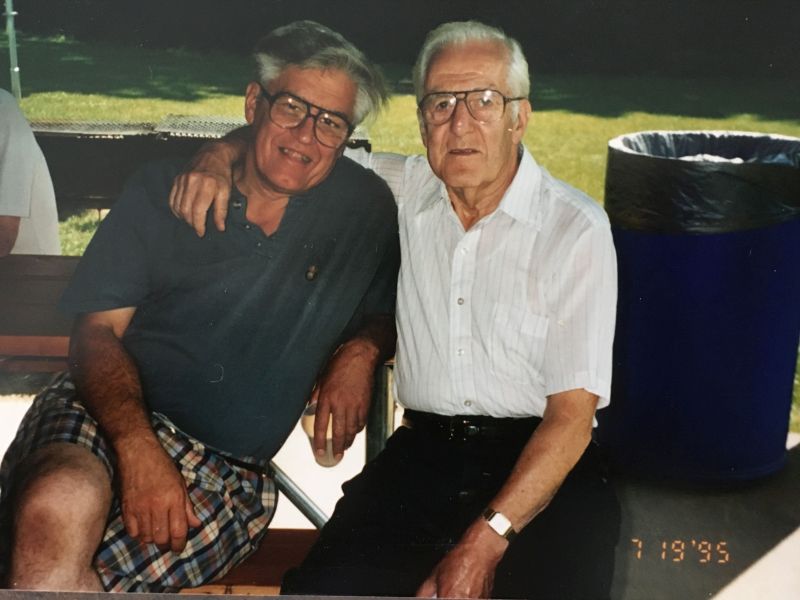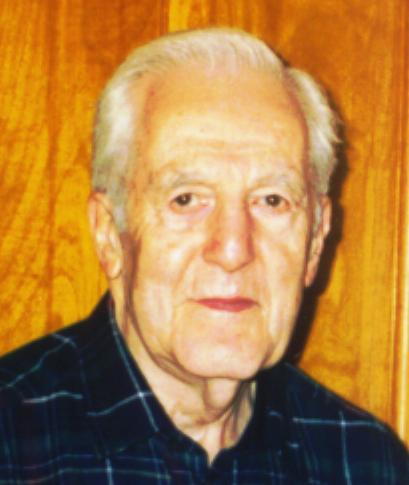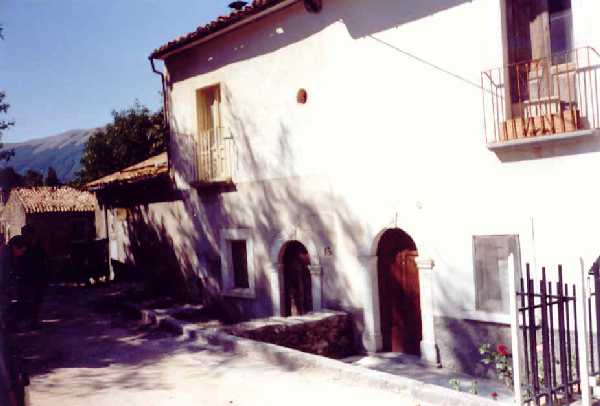 |
|
|
This is the
ancestral
DiVecchia home in Sant'Eufemia a Maiella.
The house was a
'duplex' house with two families.
You can see the two arched doors for each side of the house. The other
half of the house was owned by the Mancini family. Each side had a
living area over a basement and had a barn attached. Orginally the
living area was single story (kitchen and bedroom) but about 1928, a
second story was added (2 bedrooms and a grain storage area).No indoor plumbing. They used a pot which was dumped in a compost pit each morning. The pit was a hole in the ground filled with rocks. Each summer the pit was dug up and the composted waste was put on the fields as fertilizer. As in many Italian villages like Sant'Eufemia, the farmers lived in town and walked out to their fields to work each morning. This photo was taken in 2003. |
|
 |
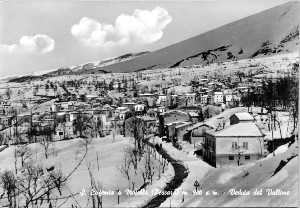 |
| The school he attended was in the municipio. Here is a 2004 photo. First grade was in the room on the first floor left. Second grade was on the right. Third & Fouth were in the second floor left. There were fewer students in those higher grades because they were out working in the fields. My dad, whose family received money from his father, Camillo, in the US, did not have to work and could attend school. | This is a 1980's vintage postcard of Sant'Eufemia a Maiella. Probably not too different from when my father left it in 1930.The parish church, S. Bartolomeo, was built in 1656 |
 |
|
My dad also was a
bell ringer at the church, S. Bartolomeo. Here
is a 2004 photo. He did it almost every day, he says because he lived
so close to the church and did not have to work in the fields. There
are three bells in the bell tower. A large bell in front, a medium bell
on the left (used for funerals), and a small bell at the rear (used for
school).
 Click on the bells above to hear a recording of the bells of S. Barlolomeo. Recorded in 1973 by my cousin, Guido Politano. |
|
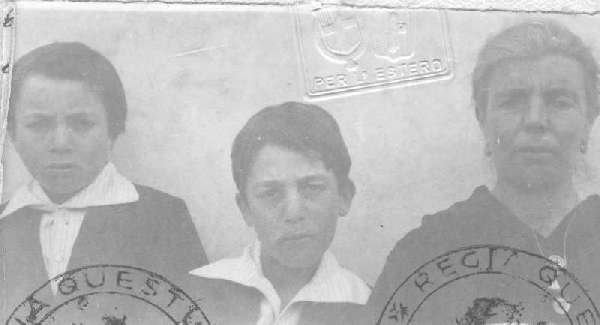 |
|
| 1930
Passport Photo.
Pasquale (12y) in the middle. Brother Antonio
(10y) on the left, mother Lucia
diGiovine (49y) on
the right. My uncle Tony had saved this and I was able to get it in July of 2004. They arrived on 23
Jun 1930 on the Conte
Grande sailing from Naples.
Going to
husband/father Camillo DiVecchia
341 Beaver Ave, West Aliquippa, PA. Daughter/sister left in Sant'Eufemia, Agnese DiVecchia. They travelled with Anna Lucia d'Addario (43y) and her two children, Elvira diPietrantonio (15y) and Lucio diPietrantonio (13y). Going to husband/father Felice diPietrantonio, 103 Thompson St, West Aliquippa, PA. Son/brother, Nicola diPietrantonio left in Sant'Eufemia. Elvira diPietrantonio D'Jovin died in 2004. |
|
| 1930 From
Sant'Eufemia, his family
(Mother, brother, Tony and himself) took the train to Naples. He
remembers that this mother got sick on that ride. Pasquale Pantalone
rode with them to Naples. He is in the photo to the right. They boarded the boat for the US there. His mother was not bothered by the boat ride, although many other ladies got seasick. They traveled with other people from Sant'Eufemia. He remembers Elvira and Antonio diPietrantionio and their mother. The boat was the Conde Grande. They had a small room with 1 regular bed and 2 bunk beds. They went to a dining room to eat. They arrived in New York and stayed there 3-4 days then took the train to Pittsburgh. They were met there by their father. This was the first time that my father remembed seeing his father. His father had been in the US continuously since 1920 so he could get his citizenship. My father was 3 years old then. My grandmother told my father "There is your father." and they shook hands. |
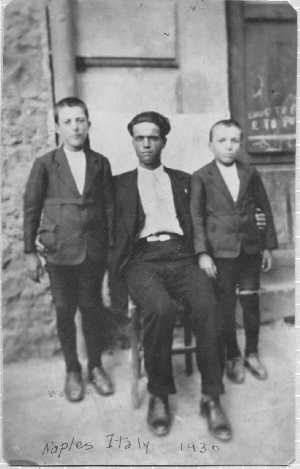 |
| . |
1930 That's my father on the left, Pasquale (Patsy)
DiVecchio. On
the right is his brother, Anthony DiVecchio. In the center is Pasquale
Pantalone who married their older sister, Eufemia. Picture
taken
in Naples, Italy as my father, his brother and their mother were coming
to the US in 1930. Passage was on the Conte Grande.
They
arrived on 23 June. I have emigration papers (Certificato Generale per
un
emigrazione) which appears to be a list of family members dated 14 May
1930. The Conte Grande was the sister ship to the Conte Biancamano, the ship that transported my mother, Benilda Frazzini, to the US in 1926 |
| My father
remembers that their
first house in Aliquippa was a 2 room
house - a bedroom and a kitchen. His parents slept in the bedroom. He
and his brother, Tony, slept in the kitchen - making up and taking down
the bed each evening and morning. They paid $10.50 per month rent. They
lived in at least five different houses over a 15 year period. Click
here
for photos. He started school in Sep 1930. Even though he was 13 years old, he did not speak any English so they put him in the first grade. Later on that school year, he was moved to the second, then third and finally fourth grade. The next four years, he attended fifth through eight grades. He remembers special English classes for immigrants. By that time he was 17 years old and he dropped out of school to go to work. One of his earliest memories is attending the Saturday matinee at the movie theater for showings of Laurel & Hardy shorts. The kids called them "fatty and skinny". When I was in Junior High school in 1961, Miss Lanabaugh, my Geography teacher remembered having my father as a student in the 1930's. I've since found one of my father's report cards from that time and it had her name on it. In 1961, Miss Lanabaugh related a story to me about my father. She remembered that in class they were building a model of a volcano (possibly out of "papier mache"). As my father was working on it, he leaned over the table holding it, lost his balance and fell right into the volcano. |
|
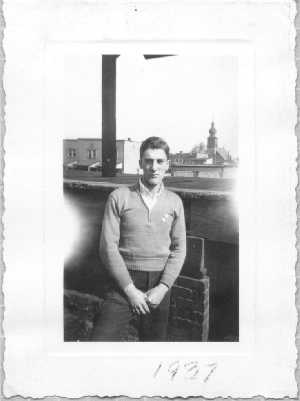 |
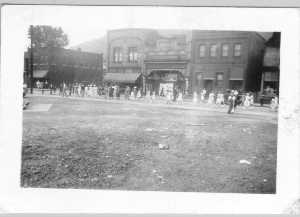 |
| 1937, Aliquippa, PA. In September 1936, he started
working on
a labor gang for the Jones
& Laughlin Steel Company
(J&L). In 1937 he moved on to the Rod & Wire
Mill. Click here for photos of some of houses where he lived in West Aliquippa. |
1937 Main Street,
Aliquippa. Saint Anthony's Day Parade West Aliquippa, PA. The building at the center left with the awning is what was Steinfeld's Hardware store. Just to its right is the movie theater. (on back of photo: Jun 14 1937) |
| In 1936, Patsy worked for a short time on the Aliquippa High School football field. His job was to keep track of working hours for all the men working on the job. This was for 2 or 3 months before he went to work at J&L. | |
| For a couple of months in 1938, the Rod Mill shut down and he was laid off. During that time, he attended the Pittsburgh Art Institute. His mother didn't like that idea - not a respectable profession. He returned to the mill when the layoff was over. Here are some examples of his work: | |
 |
|
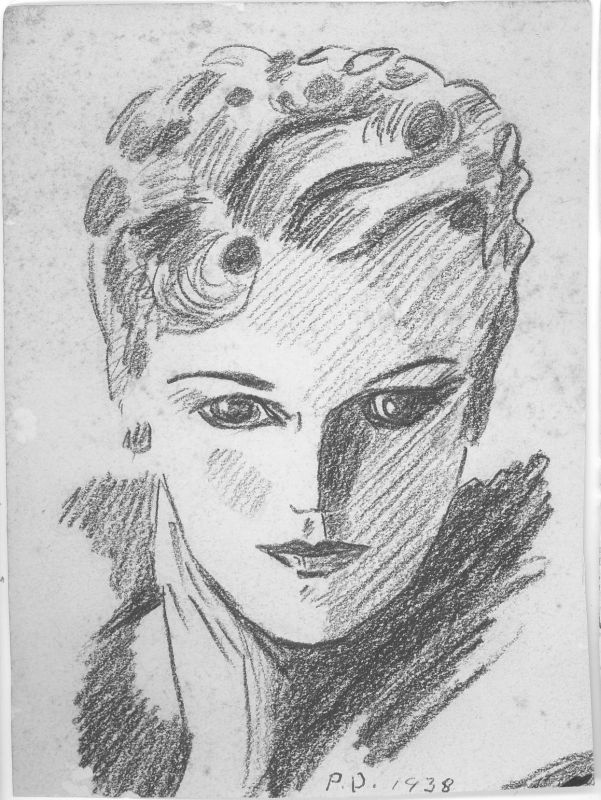 |
|
 |
|
| This is the cellar door at their home at 109½ Main in West Aliquippa,PA. This had to have been drawn after the WWII since his parents moved into this home when he was stationed in Europe. | |
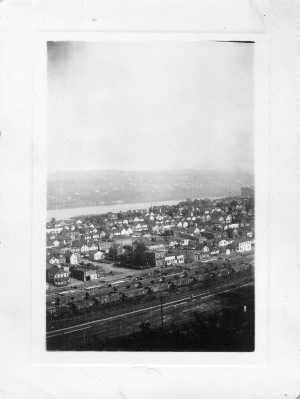 |
 |
| 1941 West Aliquippa PA. This was the original
Aliquippa. It
merged
into Woodlawn, PA (in 1928) and then this part of town became known as
West Aliquippa. |
1941 Railroads for the steel mills. Aliquippa &
Southern,
Pittsburgh & Lake Erie, New York Central and Baltimore
& Ohio. |
| My father entered the service in October 1943, first assigned to the 16th Armored Division at Camp Chafee, Arkansas. He was trained as a loader for the 105mm Howitzer (Gun Crewman Light Artillery 844). During his training, he was transfered to the 10th Armored Division (The Tiger Division), Battery "B", 419th Armored Field Artillery Battalion at Camp Gordon, Georgia, as a replacement as that division was about to be sent to Europe. The division sailed on the converted luxury liner SS Brazil after their first ship, the USS Alexander ran aground in the Brooklyn Narrows. He landed in Cherbourg on 23 September 1944, moved on to Metz and Heidelberg and at the end of the war was in Garmisch-Partenkirchen. Part of his division was surrounded in Bastogne during the Battle of the Bulge in 1944. His battery participated in the bombardment of German troops surrounding Bastogne. In March of 1945, he fought in the battle to capture the historic city of Trier. | |
 S.S. Brazil |
|
 |
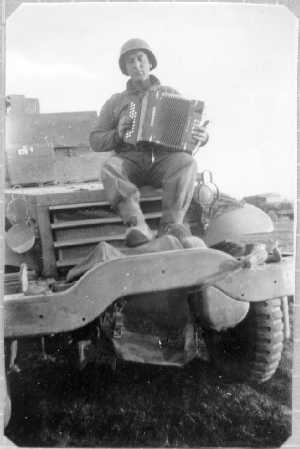 |
| 1943 US Army, Camp Chafee, AR while
he was
training with the 16th Armored Division. He was
transfered to the 10th
Armored Division as a replacement and arrived in Europe in September of
1944. The 16th
didn't get to Europe until
Feburary 1945. More details about the 16th AD. History of the 16th AD |
1945, US Army, Germany, 10th
Armored Division,
Battery "B", 419th
Armored Field
Artillery Battalion. This division, along with my father,
landed at
Cherbourg in Sep 1944. More details about the 10th AD. History of the 10th AD |
| In
July of 2004, my
cousin, Rita Politano gave me a letter that my father wrote. This was a
fantastic discovery, of course. He wrote
it to his brother,
Tony, in 1945 (Uncle Tony had been wounded at Normandy and
had been
in the hospital for almost a year):
May 28 - 45
Dear Brother Tony,
I have received your letter and picture and still hope to see a picture of you in civilian clothes soon. I was trying to figure out how many points you had and I came pretty close. I figured about 40 months in the army, two years overseas. You should have four battle stars, North Africa, Tunisia, Italy and Normandy. I don't believe any points are given for your arrowhead. You should have the purple heart, maybe a cluster too. Its a shame the way they give these purple hearts out. I thought you really had to get hurt to get one. I found out different when some of the men here got it for a few scratches so small that you can't even tell they were ever hurt. But the ----- wouldn't give me one, at least one can see a small scar where I was hit once. March 22nd to be exact. It was by strafing planes. It must have been a piece from a 20 mm. shell. It must have been a small piece. I never even felt it hit me. It was the blood running down my leg, the left one, that brought my attention to it. The medics put a patch on it. The leg was a bit stiff for about a week and that was all. Don't let our parents find out about this, they will worry over nothing. I never expected to get a purple heart for this, but when they give one to another for less, it just makes one bitch. Will tell you where all I been in a few words. I landed in Cherbourg, Sept 24, first seeing action November 1st at Metz, from there went to Luxembourg, back to France, to Germany first time November 21. To France, to Germany near Merzig. To the bulge, December 17. Left there to Metz to a rest camp December 27. Outlined 3 weeks of inspection, white washed our vehicles white and took off for the 7th Army, 17 January. Near St Arnold. Just to sit and wait where they expected a break-through that never came. On the 9th of February went back to Metz and back to the 3rd Army, to the same building and same army crap. Only one week this time. Was glad to get away from there. Even tho we did get a pass to go to town. Too many GI's tho. It happened to be just before the last big push and there must of been at least 10 divisions there. Left there about the 17th for the Saar. That must have been the heaviest fortified part of the Siegfried line. Pillboxes, dragon teeth and what have you, everywhere you looked. They came in handy even for us sometime. It was a nice place to be, when the 88's would pay us a visit. From there to Trier, took off towards Koblenz on the east side of the Moselle. Met more resistance than the 4th Armored Division. I believe it was, so they took it. We went back to Trier, 3 days of maintenance. Date must have been about March 15th. Took off southeast to Kaiserlautern and almost the Rhine but not quite near Ludwighafen. Turned south to Landau. There the last resistance west of the Rhine ended. Stayed here about 4 days before we were again told that we were again going with the 7th Army. Nobody liked it. For one reason, the chow isn't as good, too much hash and stew. We crossed the Rhine at Worms. South to Mannheim, Heidelberg, and nearly to Heilbroun. Northeast to Craislheim, 100 miles in two days. Little too far for our own good. Our supply lines were cut off. There the Nazis threw everything at us - 88's, rockets and bombed us with their jet planes. Those planes could really move. We were lucky tho, that a lot of their bombs and shells were duds. We finally had to abandon that town. Went back to Heilbroun, this time Heilbroun fell to the 100th Division. There to Stuttgart, crossed the Danube near Ulm and were heading toward Innsbruck, Austria and the Brenner Pass when on May 1st, the Division was taken out of the line. So here we are only about several miles from Austria. Waiting either to come home, staying here for the army of occupation, which I doubt, or take off for the Pacific. Its a cinch I will not be discharged, not with 42 points that I have. Yes the Germans have calmed down some. They finally realized that they have been beaten. Since you will be home June 4th, I will send this letter home to you instead of the hospital. Will end now so best of luck, So Long,
Brother Pat |
|
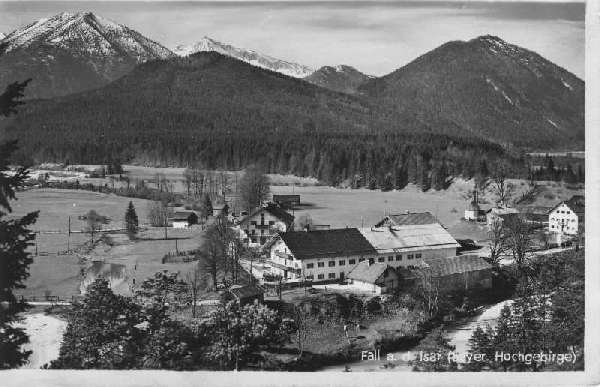 |
|
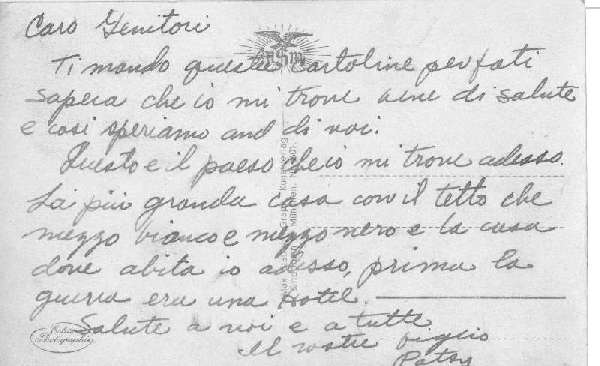 1945 a postcard from Germany that Patsy sent to his parents. My uncle Tony had saved this and I was able to get it in July of 2004. My cousin, Enzo
Pantalone (enzopant
 gmail.com), sent me this
translation in Jun of 2009: gmail.com), sent me this
translation in Jun of 2009:My Dear Parents,
I've sent you this card to let you know that I am in good health and I hope that you are too. This is the town where I now find myself. The biggest house with the half white and half black roof is the house where I now live. Before the war this used to be a Hotel. Best wishes to you and to everyone. Your son, Patsy |
|
| Here is a history of the 10th AD by the children of one its members: 419th Armd. Field Artillery Battalion, 10th Armd. Div., 1943-45, ETO, WWII... | |
| After returning from Europe in August 1945, Patsy spent several months assigned to the New York City Coast Artillery. He spent a total of 30 months in the army when he was discharged as a Private First Class in February 1946. He received the Good Conduct Medal, the American Theater Service Medal, the European Theater Service Medal and the World War II Victory Medal. | |
 This photo was taken in Boston probably just before my father got out of the Army after the Second World War. Barbara diGiovine, Lucy diGiovine, my father, Ralph Pantalone (brother of Pasquale Pantalone), James (Skippy) diGiovine. For more photos taken at the same time, check the diGiovine page. |
 Shoulder patches from both the 10th and 16th Armoured Divisions, marksmanship badges (Sharpshooter, Carbine, Machine Gun) and lapel pins. One of my my father's jobs when his unit was moving was to man the 50 cal machine gun mounted on top of a half-track. I can't find the four medals he was awarded but I have since received replacement medals from the Army. |
